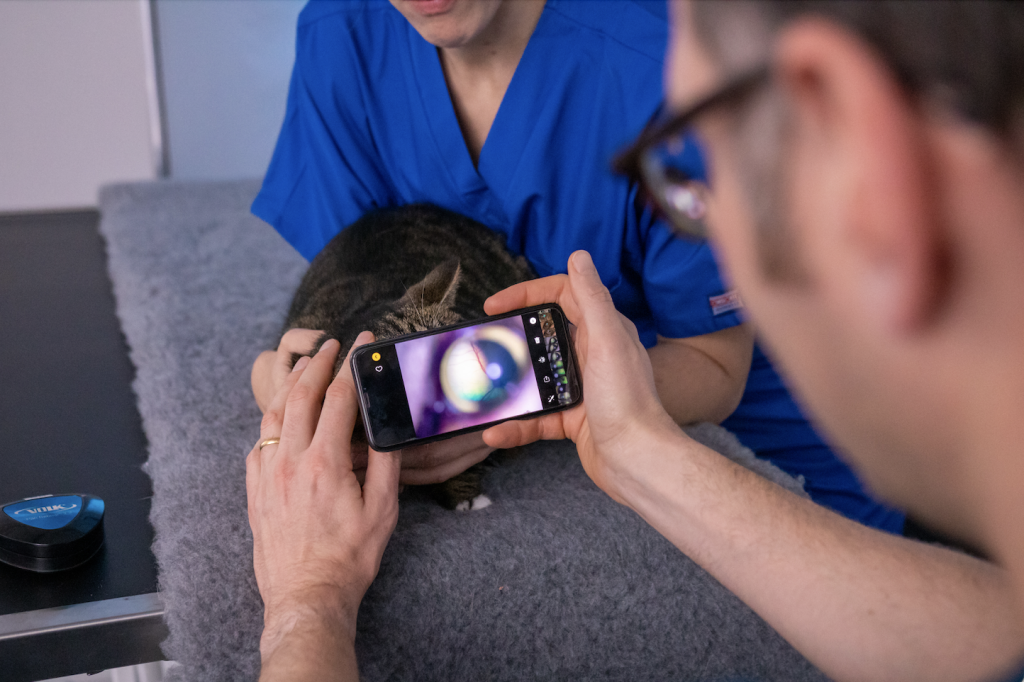
Vet Professionals Struggle To Interpret Ocular Findings When Identifying Hypertensive Lesions In Cats
A recent study1 has revealed that vets and VNs struggle to interpret ocular findings when identifying hypertensive lesions in cats.
The independent research, which was supported by Ceva Animal Health, manufacturer of Amodip, showed that while 96.5% of respondents had access to a direct ophthalmoscope, 73.1% reported that they felt underconfident in performing and interpreting ocular examinations when identifying hypertensive lesions in cats. Between 50 and 100% of hypertensive cats have ocular lesions2,3, so it is vital that clinicians feel able to identify ocular pathologies associated with high blood pressure.
To help improve confidence in ocular examinations, Ceva has developed a short online feline ophthalmology course ‘Looking hypertension in the eye’. The course will enable vets and vet nurses to get the most out of their ocular exams and gain confidence in identifying ocular lesions associated with feline hypertension. The course is presented by Dr Ben Blacklock BVSc (Hons), Dipl. ECVO, MRCVS, senior lecturer in veterinary ophthalmology at the University of Edinburgh and counts for a total of two hours’ CPD.
The study also highlighted common equipment related barriers which included: ‘cuff frustration’ (72.2%), difficulties hearing the pulse signal for doppler users, and oscillometric machines failing to give a reading at least some of the time (52.8%). Other concerns raised were situational hypertension (92%) and lack of time to take blood pressure readings (73%).
Significant owner barriers were identified such as: difficulties persuading owners to bring their cat in for blood pressure checks (86.2%) and concern over costs (80.8%).
Dr Sarah Caney, RCVS recognised Specialist in Feline Medicine who lead the study in conjunction with Professor Danielle Gunn-Moore, RCVS Feline Medicine Specialist and professor in feline medicine at the University of Edinburgh, comments: “Feline hypertension is an extremely common condition which affects approximately one in five cats nine years or over4, however there are several challenges that we need to address to enhance the long-term health and welfare of the nation’s cats. The good news is that some of the barriers identified in the study can be overcome by taking a ‘practice makes perfect’ attitude towards taking blood pressure, in that the more experience vet professionals have, the easier the procedure will become. The study showed many VNs are confident and enthusiastic about blood pressure assessment in cats; this should be encouraged and expanded upon to ensure that as many older cats and those with conditions increasing their risk of hypertension, receive the BP monitoring they deserve. VNs and vets should be encouraged to ‘upskill’ their eye examination skills, as this can be extremely helpful in identifying cats with hypertension.”
To register for the ‘Looking hypertension in the eye’ ophthalmology course visit www.veterinarywebinars.com/community/ceva. For further information on feline hypertension go to https://easethepressure.co.uk.
References
- https://journals.sagepub.com/doi/10.1177/1098612X231183244
- Taylor SS, Sparkes AH, et al. ISFM Consensus Guidelines on the Diagnosis and Management of Hypertension in Cats. J Feline Med Surg. 2017.19(3):288-303
- Young WM, et al. Visual outcome in cats with hypertensive chorioretinopathy. Vet Ophthalmol. 2018 Apr 18.
- Conroy M, Chang YM, Brodbelt D, Elliott J. Survival after diagnosis of hypertension in cats attending primary care practice in the United Kingdom. J Vet Intern Med. 2018 Nov;32(6): 1846-1855
More from Ceva
- Collaborative effort to strengthen Singapore’s preparedness against avian influenza
- Ease Pet Anxiety This Fireworks Season with Ceva's Vet-Approved Solutions
- Ceva and International Cat Care launch season 2 of cat handling training videos
- Ceva launches service to highlight the cost of infertility linked to Q fever
- Are vets and farmers under-using pain relief in dairy cows?

 2 years ago
2 years ago  1249 views
1249 views
